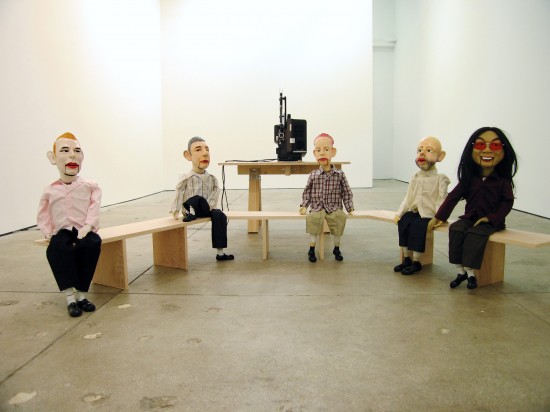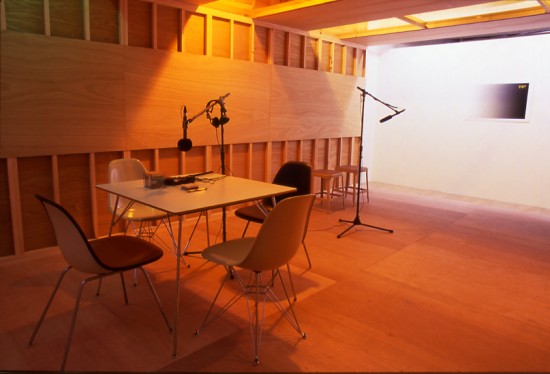III. Delicate as bias

With Philippe Parreno – Untitled (2005), five puppets each with ceramic heads, feet and hands, synthetic hair, clothes, stuffing. All images: Courtesy Rirkrit Tiravanija and Gallery Side 2, Tokyo.
ART iT: Distinct from but still related to replication, another concept that recurs variously through your works is the idea of “demonstration,” as in the “Demonstration” drawings and the “Demo Station” stages. If we generally associate demonstration with the idea of protest or speaking out, do you also understand it as the demonstration of a potential action?
RT: Yes. The reason I was interested in this imagery was the idea that people gather together to make a point or to show something, a showing for or against something. That kind of coming together is what I’m interested in. At some point my work started to become something like a platform, a space that I give to other people, both as a way to bring people together, and also in order to see things you wouldn’t normally see – people or voices that are not usually visible.
So the “Demo Stations” are one platform, and I like also that wherever they are placed, they are empty or filled in a way through “the will” of the context of the place or the people. The Land is also like that. It doesn’t have a time limit. It’s just there. It’s always open. So it can be very active or it can be nothing.
ART iT: Do you think much about the idea of social sculpture, or is that only a remote reference for you?
RT: It’s certainly a reference, and it’s important, but my idea is not to put myself in the center – that’s what I learned from it. I like the ideas around social sculpture, but how can you do something that doesn’t have a leader? It’s a struggle, because people need some kind of reference or focus point. So when I talk about “the will,” it’s about that. It’s not about me trying to get everyone to come and do it. There must be a communal will, and it has to do with usage. If people have the will, then the “Demo Station” will be used, and when it’s used then it’s great and everyone can feel the potential and they can reach certain things together that they wouldn’t be able to attain if they were being led by someone else.

Installation view of Untitled, 2001 (Demo Station No 1).
ART iT: But it’s clear that we already sculpt the space and attitudes around us, sometimes from a more top-down, directed approach, sometimes from a more or less democratic approach. Theoretically, if everybody decided to stop buying McDonalds, eventually we could have no more McDonalds. By the same token, you have the neighborhood tofu place making fresh tofu for several generations, and then at some point there’s nobody to continue the trade, so it disappears.
RT: But then at some point later, there will be a young person who comes and wants to start it up again, which happens. I’m always fascinated by the idea that people in Japan are so interested in Okinawan culture, even though they live in Tokyo or other places. That kind of longing is part of humanity. I would say you have to let things come and go, and then if we realize the potential in a natural way, good things will be made. In that sense I’m not antagonistic, but I have some kind of inherent faith in what I would call the human process. This whole “Back to Nature” movement is a great idea, but it has to be real. You can’t just say you’re interested in sustainability if you don’t recycle your plastic or if you produce a lot of garbage. These things have to come from the communal will.
ART iT: You mention this idea of longing. You have such a cosmopolitan background, is that something you play with in your own works? For example, your recreation of the Schindler House in Vienna brought an Austrian architect back “home” from the United States.
RT: Well, when I did the Schindler House I thought it was the right time to bring Schindler back to Austria, because in a way he had been completely forgotten, and this coincided with a new awareness in Austria about him and his work.
Besides Schindler, there are other things that come in cycles like that. I was always trying to go home or understand myself within my own culture. I think a lot of artists outside the Western context have that, because making art is outside of our structure, so you really have to think about what it means. What does it mean even here in Japan?
As a young artist I was always thinking about what I should do and what I am. There was an identity structure that I had to confront, and the reanimating thing with the cooking performance was part of that. But now that I’m older I realize that those concerns are always there – for everybody – and you can just do it. It’s almost more important that you let yourself be yourself. It’s not about trying to understand the bigger part of you, it’s more about understanding the smaller being that will bring out the bigger things. At the same time you always have to maintain a certain degree of doubt.

The Land (1998- ), Chiang Mai, Thailand.
ART iT: How about the reverse of being in Thailand with projects like Gallery Ver?
RT: I’ve been working long enough to say that I’ve had my fill. It’s not important for me to go to any more biennials. It’s not important for me to be in something like Documenta. Maybe what’s more important is for me to be at The Land, trying to grow shiso.
So when I felt that I no longer had to be in New York and I started to go back to Thailand more frequently, I also realized that it wasn’t important for me to make art in Thailand, because it wasn’t necessary there and wasn’t going to do anything for anyone in some ways – it may not mean anything for me to cook when everyone’s cooking everywhere. So this was already the point where I was interested in being a platform, and to work collaboratively with and support younger artists was a natural extension of that work. So it is a kind of work, but not something that would result in an exhibition. I felt it was more important to have a space for speech – and now you start to see that politically, too – because we are an old culture with a culture of respect, so we have problems critiquing the King or the laws. That’s understandable, but there needs to be space to be critical, to be aware, to say things to each other, and for young people to grow, because they are able to question their elders. I even put myself in the position of being an elder for them to question, or maybe I’m just in a place where I can be questioned and I don’t have a problem with it. The things that I’m doing in Thailand are frames for that kind of situation, so that younger artists can grow. I think that’s very important for what happens in the future. On the other hand you also have to question back. It’s not like you can criticize everything just because you can. Critique has to be constructive, it has to build things. When I question an institution I do it because I think there is some potential for something else, it’s not just about sounding off. There must be some relationship to responsibility and potential.
ART iT: You have the work with Philippe Parreno, Untitled (2005), with the puppets of yourselves as well as Pierre Hughye, Liam Gillick and Hans Ulrich Obrist. As a parody, how does that reflect your understanding of yourself?
RT: It is a parody, but also because they’re ventriloquist puppets it’s specifically about speech and talking. When we made the puppets it was about having another voice, or having a voice over our own voices.
ART iT: So it’s something like the inverse of an alter ego – rather than creating a new identity, you subvert your own identity?
RT: I actually have a double, a younger person in Thailand who appears as my substitute in some situations. It started because people would tell me that he looks like me, so I thought, why not? One of his main events was to go to China. There was a group exhibition of Thai artists curated by Josef Ng for Tang Contemporary Art in Beijing. Josef was going between Bangkok and Beijing, and whenever he went to Beijing the people there would ask him whether “Number 1” is coming, and whenever they said that they meant me, because they think I’m the “Number 1” Thai artist. I thought that was a funny idea, so basically I sent Number 1 – this other person – to fulfill their expectations. He went and shook hands, hugged people, and was generally a nice person.
This all comes back to copying and replication. And in a funny way that’s an important part of the structure in this part of the world. Of course we invent things, but a lot of the times we copy things that have already been made, and then improve them. Replication is important as a culture that addresses or questions the idea of authorship and authority.
I think it’s also about addressing certain inevitable structures. When I first started I always thought I have to do a specific thing for a very specific time, but then as I grew I realized everything you do is for a specific time. You could keep doing the same thing everyday, and each day it would still be specific. I find that interesting because everything is always changing. It’s not like there’s a unique moment. It’s all unique moments. It’s never the same pot of curry in the first place, and you could come and eat it everyday, but everyday you’re also changing and your experience changes, and that’s something that needs to be appreciated.
Return to Top
Rirkrit Tiravanija: On Exactitude in Science
